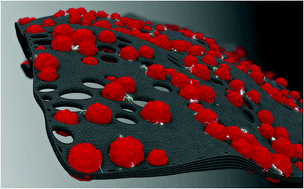Controllable design of defect-rich hybrid iron oxide nanostructures on mesoporous carbon-based scaffold for pseudocapacitive applications†
Abstract
The controllable design of functional nanostructures for energy and environmental applications represents a critical yet challenging technology. The existing fabrication strategies focus mainly on increasing the number of accessible active sites. However, these techniques generally necessitate complex chemical agents and suffer from limited experimental conditions delivering high costs, low yields, and poor reproducibility. The present work reports a new strategy for controllable synthesis of a hybrid system including mixed iron oxide nanostructures enriched with non-stoichiometric Fe21.34O32 and Fe3+[Fe5/33+□1/32+]O4 phases, which possess a high concentration of oxygen and Fe2+ vacancies, and a mesoporous carbon-based scaffold (MCS), which was dervied from coffee residues, with graphitic surface and perforated architecture. The nanoperforates acted as trapping sites to localise the FexOy nanoparticles, thereby boosting the density of accessible active sites. Additionally, at the interfacial regions between the FexOy crystallites, a high density of oxygen vacancies with an oriented pattern was shown to create superlattice structures. The energy storage functionality of the defect-rich MCS/FexOy nanostructure with nanoperforated architecture was investigated, where the results exhibited a high gravimetric capacitance of 540 F g−1 at a current density of 1 A g−1 with outstanding capacitance retention of 73.6% after 14 000 cycles.



 Please wait while we load your content...
Please wait while we load your content...